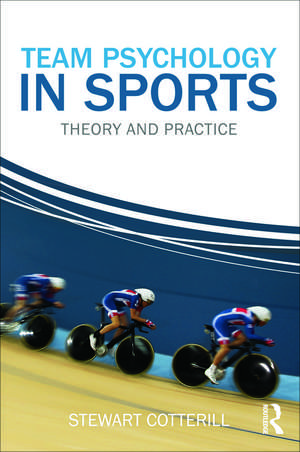Team Psychology in Sports: Theory and Practice
Autor Stewart Cotterillen Limba Engleză Hardback – 15 iun 2012
The book neatly bridges the gap between theory and practice, with real sporting case studies, examples and practical tools included in each chapter. It covers the full range of issues in team sport, including:
- planning
- communication
- cohesion
- motivation
- emotions
- momentum
- leadership
- recovery.
| Toate formatele și edițiile | Preț | Express |
|---|---|---|
| Paperback (1) | 347.92 lei 3-5 săpt. | +18.31 lei 6-10 zile |
| Taylor & Francis – 14 iun 2012 | 347.92 lei 3-5 săpt. | +18.31 lei 6-10 zile |
| Hardback (1) | 999.64 lei 6-8 săpt. | |
| Taylor & Francis – 15 iun 2012 | 999.64 lei 6-8 săpt. |
Preț: 999.64 lei
Preț vechi: 1219.08 lei
-18% Nou
Puncte Express: 1499
Preț estimativ în valută:
191.28€ • 208.43$ • 161.18£
191.28€ • 208.43$ • 161.18£
Carte tipărită la comandă
Livrare economică 23 aprilie-07 mai
Preluare comenzi: 021 569.72.76
Specificații
ISBN-13: 9780415670579
ISBN-10: 0415670578
Pagini: 184
Ilustrații: 8 Tables, black and white
Dimensiuni: 156 x 234 x 13 mm
Greutate: 0.44 kg
Ediția:1
Editura: Taylor & Francis
Colecția Routledge
Locul publicării:Oxford, United Kingdom
ISBN-10: 0415670578
Pagini: 184
Ilustrații: 8 Tables, black and white
Dimensiuni: 156 x 234 x 13 mm
Greutate: 0.44 kg
Ediția:1
Editura: Taylor & Francis
Colecția Routledge
Locul publicării:Oxford, United Kingdom
Public țintă
Postgraduate, Professional, and UndergraduateCuprins
PREFACE Chapter One. Introduction Chapter Two. Team planning and effectiveness Chapter Three. Developing a positive team environment Chapter Four. Role clarity and role acceptance Chapter Five. Developing effective team communication Chapter Six. Cohesion in sport Chapter Seven. Motivating the team Chapter Eight. Managing emotions in team sports Chapter Nine. Momentum in sport Chapter Ten. Effective team leadership Chapter Eleven. Mental and Emotional Recovery
Descriere
Team Psychology in Sports examines the crucial factors in the development of an effective team, introducing important psychological and organizational concepts and offering evidence-based interventions for enhancing the performance of any sports team. The book neatly bridges the gap between theory and practice, with real sporting case studies, examples and practical tools included in each chapter. No other book offers such an up-to-date, relevant and applied guide to working with sports teams. It is essential reading for all students and practitioners working in sport psychology or sports coaching.





